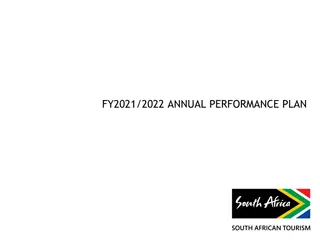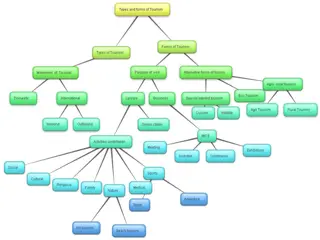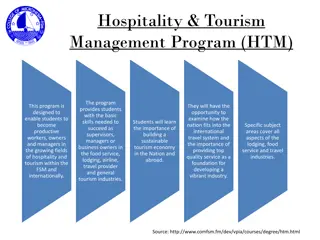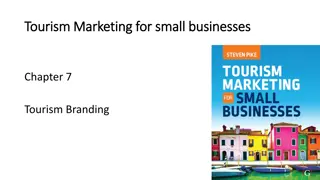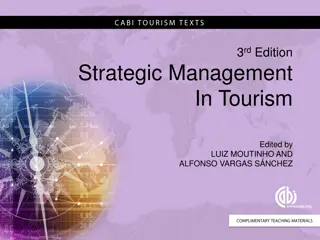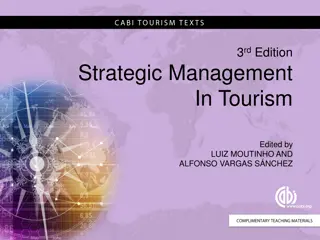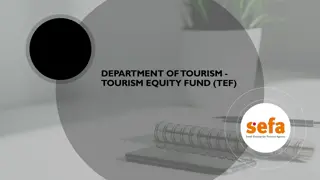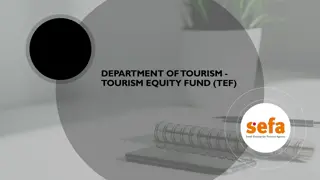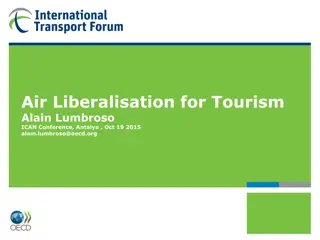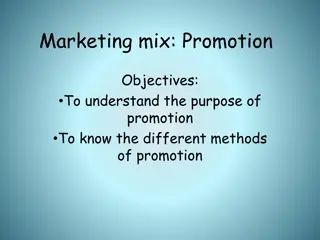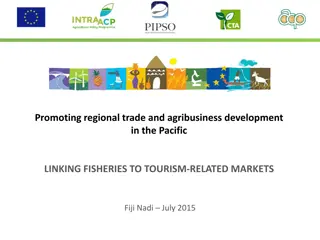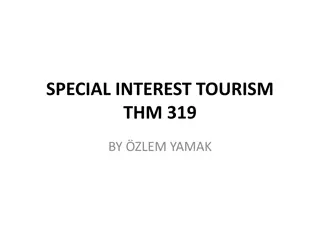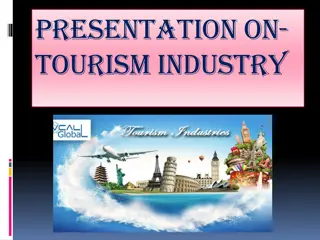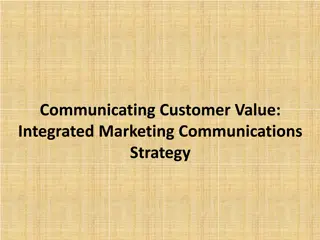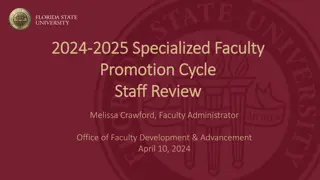Enhancing Tourism Marketing through Promotion Strategies
The chapter delves into the significance of promotion in the tourism industry, outlining the six-step marketing communications process and key approaches used for promoting tourism services to consumers. It discusses promotion budget setting methodologies such as affordability, industry averages, ratio of sales, and aligning with marketing objectives, offering insights on stimulating demand, informing consumers, and encouraging action through creative marketing communications.
Download Presentation

Please find below an Image/Link to download the presentation.
The content on the website is provided AS IS for your information and personal use only. It may not be sold, licensed, or shared on other websites without obtaining consent from the author. Download presentation by click this link. If you encounter any issues during the download, it is possible that the publisher has removed the file from their server.
E N D
Presentation Transcript
Tourism Marketing for small businesses Tourism Marketing for small businesses Chapter 9 Promoting Tourism Services to Consumers
Chapter learning aims Chapter learning aims To enhance your understanding of: the role of promotion in the marketing plan the six-step marketing communications process the main approaches used in promoting tourism services to consumers
Key terms Key terms Promotion Promotions are communications in the market, aimed at stimulating demand to generate customers (sales). Marketing communications Also referred to as MarComs or Comms, and often used interchangeably with the term promotion, this represents the integration of the message and the media used in the promotional mix to communicate with target consumers. Hierarchy of needs/AIDA A theory proposing advertising should lead consumers through a process from reminding them of their needs though to making a purchase. A variation of this is the AIDA model of enhancing Awareness, stimulating Interest, creating Desire, which leads to Action (purchase).
The role of promotion The role of promotion To stimulate demand and generate customers (sales) Key goals involve informing consumers (awareness), and then persuading and reminding them to act (purchase) Effective marketing communications require creative ideas to be developed from the critical objective setting in the marketing planning stage Eg What objective will this promotion achieve?
Promotion budget setting approaches Promotion budget setting approaches Affordability. The simplest approach is to set a budget based on what the business can afford. Most small tourism businesses operate with an uncertain future cash flow and so this approach does actually represent reality rather than what might be ideal. Industry average. This approach results in a promotion budget based on analysis of what competitors are spending. Similar to going rate pricing, where prices are set to match the competition, the assumption is there is a collective wisdom within the sector.
Promotion budget setting approaches Promotion budget setting approaches Ratio of sales. This is based on a percentage of past or projected sales, and might be flexible to adjust to actual sales on a monthly basis for example. In this way promotion budget levels are a result of sales, as well as the cause. Marketing objectives. An assessment is made of the range of initiatives best suited to achieve the objectives, and these are then costed. If there are clear performance measures, this approach makes the most sense, particularly in terms of justifying the budget rationale to stakeholders such as financiers and investors.
The marketing communication process The marketing communication process 1. Select the marketing objective being addressed The situation analysis (where are we now?) enables the development of the marketing objectives (where do we want to get to?). The first step in designing a specific promotion is to determine which marketing objective is being addressed. 2. Specify the target segment Most businesses cater to more than one segment, which by definition means groups of consumers sharing similar needs and/or characteristics. The differences between segments influence the type of message to be communicated, and the media to be used.
The marketing communication process The marketing communication process 3. Determine the desired response The overall aim of promotion is to stimulate demand to generate sales. However, different objectives might be related to leading different segments through varying stages of a process based on the Hierarchy of Needs theory (see Lavidge & Steiner, 1961: Stimulating recognition of their needs, to create a want for our type of service. Increasing brand salience, which represents top of mind awareness of our service when a tourism situation is being considered to satisfy a want. Enhancing the brand image, so they develop a favourable attitude towards our service, relative to competitors. Stimulating intent to purchase, through a call to action.
The marketing communication process The marketing communication process 4. Design the message All marketing communications should be aimed at stimulating purposeful dialogue with the target consumers. Therefore the message must be meaningful to them, by communicating a value proposition that addresses their needs and wants. To cut through the clutter of the noise of competing tourism services and substitute products means messages must be distinctive, and focused on stimulating the desired response. The message also needs to be easily understandable, realistic and believable. No matter how incredible the offer, if it s not backed by a good service at a good price it s not going to work in the long term.
The marketing communication process The marketing communication process 5. Select the type of promotion Different objectives related to the AIDA process require different promotional tactics and media. For example, advertising can be effective in enhancing awareness, whereas personal selling is more effective at closing a sale. 6. Monitor the impact How will we know if we have achieved the objective? The results of some types of promotions (eg coupons) are easier to monitor than others (eg roadside billboard). This topic is discussed fully in Chapter 14 Tourism Marketing Performance Measurement.
Advertising Advertising One big idea Attention grabbing, with a meaningful value proposition Reinforce the brand identity The image aspired to in the market Well scripted To the point, short and snappy Call to action Let the target know how you want them to respond
Advertising Advertising Potential advantages Potential disadvantages High reach at a low cost per reader Lower credibility and believability Enables visual creativity Easy for consumers to not pay attention Useful for enhancing brand salience and Difficult to get noticed in the advertising brand image clutter Opportunity to reach new consumers Difficult to close a sale Opportunity to include a call for action Difficult to measure effectiveness Non-invasive contact High wastage Many available media formats High cost of prime media space Ability to target segments through niche Short life span media Short lead times possible
Sales promotions Sales promotions Essentially incentivised offers Eg discount coupons Short term initiatives when there is an urgent need to boost sales and cash flow A key advantage is the ability to track responses A disadvantage is stimulating potential price war with competitors
Personal selling Personal selling The most effective means to build trust, reduce perceived risk, and close a sale Eg at consumer expos The art of selling is to take the fear out of saying yes Ability to hold the consumer s attention and gain feedback Ability to measure effectiveness One of the most expensive forms of promotion
Direct (e)mail Direct (e)mail Communicating directly with consumers via mail, email and SMS Enables high audience selectivity Eg a data base mailing list Messages tailored to appeal to the needs of target audience Useful for following up after other forms of promotion Ethical and legal implications Difficult to stand out from the clutter of other direct marketers Ability to monitor responses
Point of sale Point of sale Situated on-site at the point of payment Eg cash register, restaurant table Aims to stimulate impulse buying Typically sales promotion offers Eg competition, bundle discount, giveaways Often offers are made for certain times of the day/week Eg daily happy hour, mid-week specials
Consumer expos Consumer expos Manning a physical presence at: Travel expos Lifestyle expos eg boating, camping, fishing, food & wine, home & garden Cultural festivals Major sporting events featuring expos eg major marathons Participation can be expensive Ability to combine personal selling with other forms of promotion Eg sales promotions, brochures Ability to gain contacts for direct mail database eg through a competition Difficult to monitor effectiveness
Experiential Experiential AKA events marketing and engagement marketing Staging promotional event in high traffic areas Passers-by encouraged to participate in an activity Aim is to get consumers to engage with the brand Creative promotions can attract media publicity on viral publicity on social media Difficult to monitor effectiveness
Networking and cooperating to compete Networking and cooperating to compete A key aim of DMOs is to foster a spirit of cooperating to compete Small businesses, who might compete locally, working together to attract more visitors To stretch promotional resources To create a bigger market impact than could be achieved by individual businesses working in isolation Particularly effective at consumer expos Networking events enable information sharing
Discussion questions Discussion questions What is the purpose of promotion? What is the difference in meaning between the terms promotion and marketing, and why is promotion sometimes incorrectly referred to as marketing? With so many different forms of promotion and types of media channels, on what basis should a particular approach be selected?





